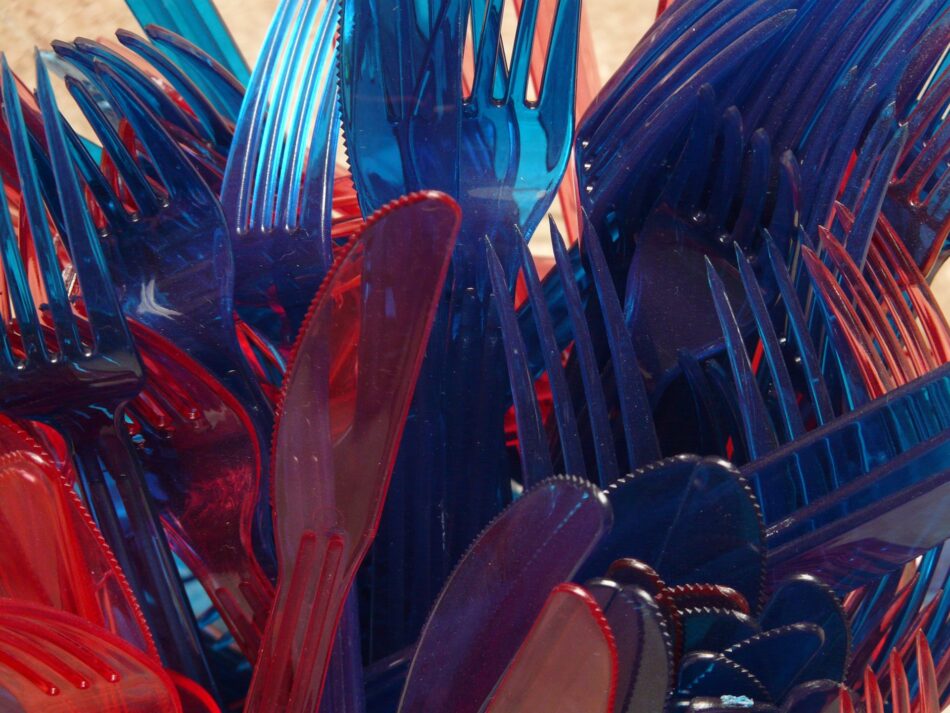How to Reduce Recycling Contamination
Contaminated recycling causes problems and means waste goes to landfill or is incinerated. Find out how to reduce recycling contamination in your business.

Disposable cutlery is convenient and used in many areas of our daily lives. It makes washing up a piece of cake if you have a party. Businesses such as takeaways, fast food chains, and airlines often provide them with your meal as a hygienic and easy option. But plastic cutlery takes around 1,000 years to decompose.
Disposable cutlery offers a quick, throwaway solution, though it has a significant impact on our environment – especially when got rid of incorrectly. Understand how to dispose of plastic cutlery in a safe way with these answers to some of your most asked questions.
Disposable cutlery became popular after WW2, as plastic became more commonly used in the home. Manufacturers saw this as an opportunity to create plasticware that could be thrown away after one use. Because they required no water, electricity, or manpower to wash, they became popular with fast-food restaurants and airlines.
Disposable cutlery is made from one of two different types of plastic – either polypropylene or polystyrene. There are more types of disposable cutlery being introduced made from wood and even biodegradable materials – check the packaging to make sure.
Unfortunately, you can’t recycle most disposable cutlery as polystyrene plastics can’t yet be recycled. This means you must throw them away with your general waste, so they’ll end up in landfill or incineration. If you have polypropylene cutlery, you might be able to recycle it – but check with your local authority first.
One of the reasons why you can’t recycle most disposable plastic cutlery is that recycling machines can mistake it for paper – due to being small and lightweight. This can cause problems with sorting, contaminating recycling, and even clogging machines.
Unfortunately, as it’s not recyclable most polystyrene cutlery will go to landfill or be incinerated. While incineration saves landfill space, the greenhouse gases it emits have a negative impact on our environment. However, after collection polypropylene plastic cutlery is sorted, cleaned, reprocessed, melted into pellets that are used to create new products.
If plastic cutlery isn’t recyclable and is disposed of with general waste, it can end up in landfill and take hundreds of years to decompose. Sometimes it may be incinerated instead, to save landfill space. However, this releases toxic gases such as dioxins, furans, mercury, and polychlorinated biphenyls into the atmosphere that contribute to air pollution.
Even when recycling disposable cutlery made from polypropylene, it must be heated at a temperature of 2,400°C. This is expensive and can still cause similar fumes to enter the atmosphere, which further damages the environment. This material can’t be constantly recycled, meaning it will end up in landfill during its lifecycle.
Yes – the most obvious alternative to disposable plastic cutlery is reusable cutlery, such as metal cutlery. Businesses should use this type of cutlery in their kitchens and for any events, wherever possible. However, while this is a simple solution for homes, it’s not necessarily an option for takeaways, fast food restaurants, and airlines.
The most eco-friendly alternative here is to use biodegradable wooden cutlery. This is entirely compostable and will biodegrade much faster than plastic. Many companies are already making the switch to this type of cutlery, and this trend is likely to continue and grow.
If you’ve had a big party or used plastic cutlery at a picnic, another way to protect the planet and avoid throwing it away is to simply wash it and re-use it. Although some pieces may break, plastic cutlery can be used multiple times and is convenient for gatherings or using when you’re away from home.
A few facts about disposable cutlery are that:
In most cases, you can dispose of polypropylene cutlery alongside your other household recycling for free, if your local council accepts this type of plastic. Polystyrene cutlery can be thrown away with your general waste for free. Businesses need to pay for commercial waste collection whatever type of disposable cutlery you’re throwing away with general waste or plastic recycling.
The best and cheapest way to dispose of plastic cutlery is to not use it at all. Instead, opt for cheap wooden versions or stick with traditional metal cutlery.
Find out more about other rubbish streams.
Get a fast FREE quote for your plastic waste
Contaminated recycling causes problems and means waste goes to landfill or is incinerated. Find out how to reduce recycling contamination in your business.
Many tourist hotspots look great in the photos but are sadly surrounded by rubbish and litter. Discover the 10 dirtiest hotspots in the world to avoid.